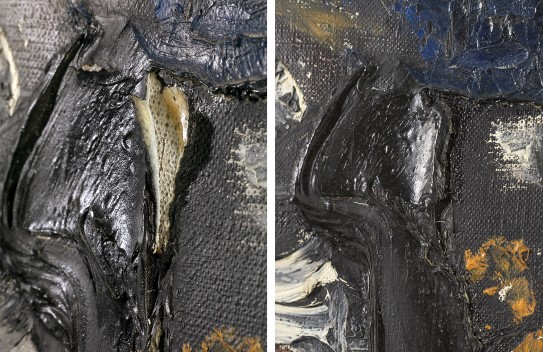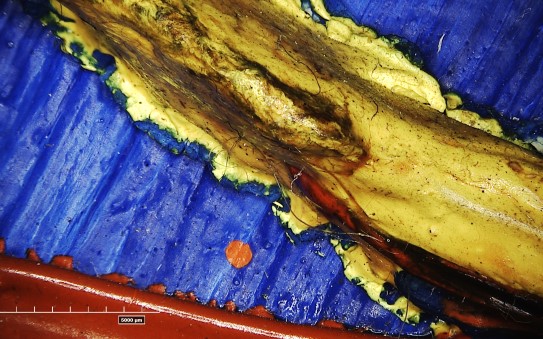Soft and dripping paint

Examination of the condition issues in oil paintings dated between 1946 and 1972.
The project examines condition problems in modern paintings made by artists who were associated with either the Cobra movement or exhibitions such as "Art Autre". Through examination of how soft and dripping paint manifests in a select group of paintings the project presents new knowledge and challenges earlier research on Asger Jorn and Karel Appel.
The aim of the project was to improve the understanding of condition problems in modern paintings containing soft and dripping paint and to apprehend the reasons why these occur. The examination focused on 23 paintings, from the period 1946-1972, by Asger Jorn, Karel Appel and four other artists at one time associated with either the Cobra movement or exhibitions such as Art Autre.
In this process, conceived ideas about the making of these modern paintings and the relation with the condition problems are challenged:
i) The conceived idea of so-called good and bad materials.
ii) The lack of schooling and understanding of the materials and their application.
iii) The economically difficult conditions that directly affected the quality and durability of the works the artists produced.

The results are presented in the thesis «French Connections: Soft and Dripping paint in Cobra and Art Autre (1949-1972)». A central find from the research is that the problem of soft and dripping paint occur in a period when the artists worked in Paris under relatively affluent financial circumstances, and utilized for the most part regular artist paint from French brands such as Lefranc, Lefranc-Bourgeois, Lefevbre-Foinet and Adam Montparnasse.

These and other new insights into the artists’ practices urges a re-interpretation or re-evaluation of earlier research in particular on Asger Jorn and Karel Appel.
Researcher in the project:
Dr. Ida Antonia Tank Bronken, Paintings conservator Nasjonalmuseet
Phd at the University of Amsterdam, Netherlands.
Supervisors:
prof. dr. K.J. van den Berg, Universiteit van Amsterdam
prof. dr. E. Hendriks, Universiteit van Amsterdam
This project has been supported by:
UNI-stiftelsen
HZB Helmholtz Zentrum Berlin, Bessy II
Getty Conservation Institute, Science department
Henie Onstad Art Centre
Related publications
Bronken, I. and Boon, J. (2014a) Hard dry paint, softening tacky paint, and exuding drips on Composition 1952. In: Issues in Contemporary Oil Paints. Proceedings from the Symposium, 28 and 29 March 2013. van den Berg, K.J., Burnstock, A., de Tagle, A., de Keijzer, M., Heydenreich, G., Krueger, J. and Learner T (eds.). Amersfoort: Springer.
Bronken, I.A.T. and Boon, J.J. (2014b) Softening paint and drip formation in paintings by Jean-Paul Riopelle (1923–2002): improving their condition with metal coordinating ions. In: Preprints of the ICOM-CC 17th Triennial Conference. Bridgland, J. (ed.). Paris: ICOM, art. 1303.
Bronken, I. and Boon, J. (2015) Conservation challenges and physical changes in Composition (1952) by Jean-Paul Riopelle: a case study. In: Public Paintings by Edvard Munch and his Contemporaries: Change and Conservation Challenges. Frøysaker, T., Streeton, N., Kutzke, H., Hanssen-Bauer, F., Topalova-Casadiego, B. (eds.). London: Archetype publications.
Bronken, I., Boon, J.J. and Vila, A. (2015) In search of a solution for softening and weeping paints in contemporary paintings by Tal R and Frank van Hemert. In: Current challenges in Paintings Conservation, Barros D´Sa, A., Bone, L., Clarricoates, R. and Dowding, H. (eds.). London: Archetype publications.
Bronken, I., Boon, J., Corkery, R. and Steindal, C.C. (2019a) Changing surface features, weeping and metal soap formation in paintings by Karel Appel and Asger Jorn from 1946 – 1971. In: Journal of Cultural Heritage 35 (2019).
Bronken, I., Boon, J. and Steindal, C.C. (2019b) Examination of paint delamination in C'est grace à nous by Asger Jorn. In: Conference on Modern Oil Paints. Springer.
Bronken, I.A.T., Boon, J.J. and Steindal, C.C. (2021) Delamination of the paint structure in Peinture, dated 1954 by Pierre Soulages: a study on soap formation in the paint layer interface, Meddelelser om konservering, pp. 51–64. Available at: https://mok.scholasticahq.com/article/31734.pdf (accessed 12 June 2022).
Fujisawa, N., Bronken, I.A.T., Freeman, A.A. and Łukomski, M. (2022) Nanoindentation of softening modern oil paints. In: International Journal of Solids and Structures.
Bronken, I.A.T. (2022) Investigations into 20th-century painting materials: using studio studies and archival research methodology to recreate material practices. Munch2022, 21-23 March 2022, Oslo.
Bronken, I.A.T. (2023) Soft Paint and the Care of Paintings. London: Archetype publications.
Conference paper
Bronken, I., Fuijsawa, N. and Łukomski, M. (2022) Modern life in the museum. Nanoindentation study of soft and dripping oil paints in four artworks by Karel Appel and Asger Jorn. Paper presented at the “Reflecting on the past, Imagining the Future.” AIC conference, 13-19 May 2022, Los Angeles. [Unpublished]
Contact
Ida Antonia Tank Bronken
Paintings conservator at Nasjonalmuseet
ida.bronken@nasjonalmuseet.no
Research Gate
Tlf: +47 990 13 281